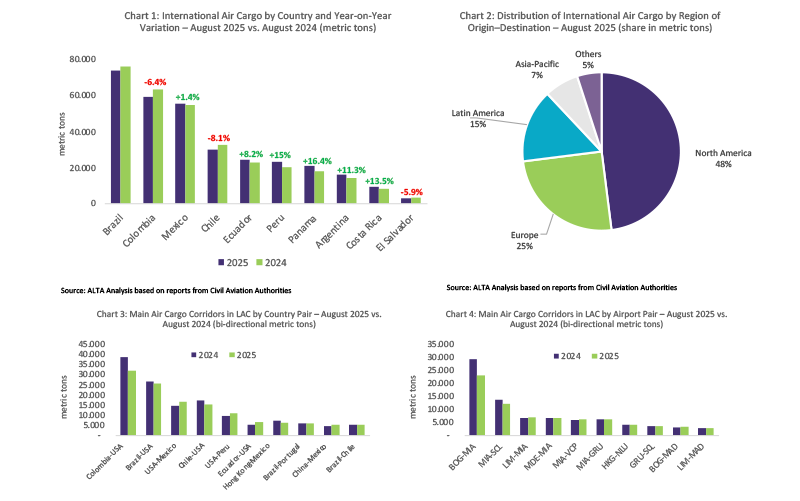International Air Cargo in LAC’s Main Markets Grows 0.7% in August
International air cargo traffic to and from Latin America and the Caribbean recorded a 0.7% year-on-year increase in August 2025, measured in metric tons carried.
November 17, 2025

International air cargo traffic to and from Latin America and the Caribbean recorded a 0.7% year-on-year increase in August 2025, measured in metric tons carried. The figure reflects a slowdown in regional growth compared with the 2.2% expansion in July. International cargo accounted for around 85% of the total air-freight volume during the month, with Brazil remaining the leading market, followed by Colombia and Mexico (see Chart 1).
Deceleration in the Main Markets: Brazil and Colombia
Brazil, the region’s largest air cargo market, recorded a 3.1% year-on-year contraction in August, handling approximately 74,000 metric tons (see Chart 1). The Brazil–United States corridor — which represents about 35% of Brazil’s total international cargo volume — explained roughly half of the decline. Shipments from Brazil to the U.S. dropped 12.2%, while the reverse flow decreased 1.3%. This was the corridor with the largest net reduction of the month. The steepest declines were seen in goods under tariff chapters 84 (reactors and machinery, –279 t), 70 (glass and glassware, –178 t), and 88 (aircraft and parts, –96 t)[1]. The overall performance also reflected the impact of the new U.S. import tariffs, which since August apply a 50% duty on several Brazilian-origin products, with a few exceptions that remain at 10%[2].
Colombia posted the sharpest annual decline so far this year, down 6.4% versus August 2024 (see Chart 1). The Colombia–United States corridor — which represents more than half (54%) of the country’s total air-cargo volume — fell by about 6,500 tons (see Chart 3), accounting for virtually the entire national decrease. Shipments from Colombia to the U.S. dropped 16.7%, while flows in the opposite direction decreased 17.3%. In contrast, routes with Mexico and the Netherlands expanded 44% and 54% year-on-year, respectively.
Mexico, the region’s third-largest air-cargo market, moved 56.7 thousand tons in July, a 1.4% year-on-year increase (see Chart 1). Cargo flows between Mexico and the U.S. — the country’s most important route and the third largest in the region — accounted for roughly 30% of total international volume and grew 14.4%, driven by southbound shipments from Mexico (+23.4%) and a more moderate northbound increase (+8.3%). Felipe Ángeles Airport (NLU) led growth with +80.1%, followed by Guadalajara (+40%), while Mexico City (MEX) recorded a 13.6% decline.
Expanding Markets: Peru, Panama, Argentina, and Costa Rica
While the main markets faced a less favorable environment, four countries posted double-digit growth in August (see Chart 1). Together, Peru, Panama, Argentina, and Costa Rica accounted for around 22% of the region’s total international air-cargo volume during the month.
- Peru grew 15% year-on-year, totaling 23,243 tons.
- Panama handled 20,958 tons, up 16.4% from a year earlier.
- Argentina recorded an 11.3% year-on-year increase in international cargo, totaling 15,996 tons.
- Costa Rica rose 13.5% year-on-year, with a total of 9,516 international tons.
“August showed a mixed performance for air cargo across the region. Major markets like Brazil and Colombia adjusted to lower trade flows with the United States, while smaller countries such as Peru and Panama recorded double-digit growth.
Overall, the data reflect an ongoing adjustment to new international trade conditions,” said Peter Cerdá, CEO of ALTA.
Contrasting Results in Chile and Ecuador
Chile and Ecuador, which together represent about 17% of the region’s international air-cargo volume, showed divergent performances in August 2025. In Chile, international air cargo fell 8.1% year-on-year, marking the eighth consecutive month of decline. In contrast, Ecuador recorded 8.2% year-on-year growth%.

Capacity: B747F Accounts for 37% of Cargo Capacity; B767 Leads Year-on-Year Growth
In August, freighter aircraft capacity to and from LAC declined 1% year-on-year, totaling just over 885 million ton-kilometers, following a marginal 0.3% increase in July. The B747F accounted for 37% of total operated capacity, while the B767F and A330F were the only aircraft types showing growth, up 63.1% and 15.7%, respectively (see Chart 5).

[1] Ministry of Development, Industry, Trade and Services (MDIC) – ComexStat, “Exports and Imports by HS Chapter, Brazil–United States, August 2025.” Available at: https://comexstat.mdic.gov.br
[2] Federal Register, Executive Order 14323 of July 30, 2025: Addressing Threats to the United States by the Government of Brazil, Vol. 90, No. 37739 (2025). Available at: https://www.whitehouse.gov/presidential-actions/2025/07/addressing-threats-to-the-us/


























